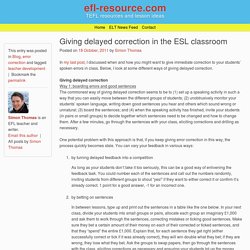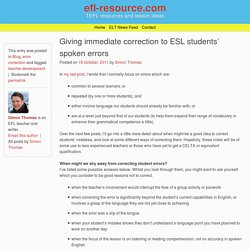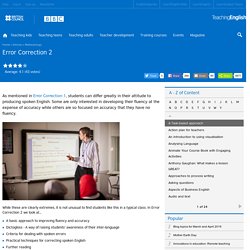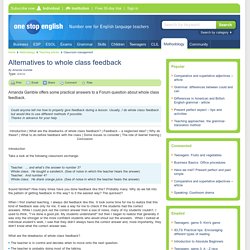

SelfPeerAssessment. Giving delayed correction in the ESL classroom. In my last post, I discussed when and how you might want to give immediate correction to your students’ spoken errors in class.

Below, I look at some different ways of giving delayed correction. Giving delayed correction Way 1: boarding errors and good sentences The commonest way of giving delayed correction seems to be to (1) set up a speaking activity in such a way that you can easily move between the different groups of students; (2) unobtrusively monitor your students’ spoken language, writing down good sentences you hear and others which sound wrong or unnatural; (3) board the sentences; and (4) when the speaking activity has finished, invite your students (in pairs or small groups) to decide together which sentences need to be changed and how to change them.
After a few minutes, go through the sentences with your class, eliciting corrections and drilling as necessary. Wvvideospeakingrubric. Giving immediate correction to ESL students’ spoken errors. In my last post, I wrote that I normally focus on errors which are: common to several learners; orrepeated (by one or more students); andeither involve language our students should already be familiar with; orare at a level just beyond that of our students (to help them expand their range of vocabulary or enhance their grammatical competence a little).

Over the next few posts, I’ll go into a little more detail about when might be a good idea to correct students’ mistakes, and look at some different ways of correcting them. Hopefully, these notes will be of some use to less experienced teachers or those who have yet to get a CELTA or equivalent qualification. When might we shy away from correcting student errors? I’ve listed some possible answers below. Obviously the last two reasons seem more like excuses. When might it be good not to accompany a correction with an explanation of why the original sentence is ungrammatical or unnatural-sounding? Some problems with the above structure are: Error Correction 2. While these are clearly extremes, it is not unusual to find students like this in a typical class.

In Error Correction 2 we look at... A basic approach to improving fluency and accuracy Dictogloss - A way of raising students' awareness of their inter-language Criteria for dealing with spoken errors Practical techniques for correcting spoken English Further reading A basic approach to improving fluency and accuracy In contrast to writing, students have very little processing time when it comes to speaking, so it is hardly surprising that the following may occur. Students don't experiment with new language presented by the teacher. At lower levels students' output is mostly lexical. Just as with writing we can help students to improve their accuracy and fluency. When it comes to accuracy, research into second language acquisition says that the first stage of improving accuracy is awareness-raising. 1.
Alternatives to whole class feedback. By Amanda Gamble Amanda Gamble offers some practical answers to a Forum question about whole class feedback.

Could anyone tell me how to properly give feedback during a lesson. Usually, I do whole class feedback but would like to use different methods if possible. Thanks in advance for your help. Introduction | What are the drawbacks of whole class feedback? Anchor Point:1Introduction Take a look at the following classroom exchange: Teacher: ... and what’s the answer to number 3? Sound familiar? When I first started teaching, I always did feedback like this. Anchor Point:2What are the drawbacks of whole class feedback? The teacher is in control and decides when to move onto the next question. More importantly, it doesn’t tell the teacher what problems the students had with the activity or if they need further practice. In a communicative, learner-centred classroom whole class feedback goes against the grain. Anchor Point:3Feedback – a neglected idea? I want to concentrate on the third one. 1. Mistakes, Errors, and Correction. User Rating: Details Parent Category: Articles Category: Feedback and Correction Written by Chris Cotter Imagine a pair of your intermediate students has the following conversation: A: What are you going to do at Saturday afternoon?

Do you correct the conversation? As teachers, we must decide whether or not to offer correction in each and every class. Before answering the initial question of what to correct, a distinction should be made between a student who uses previously learned material incorrectly and a student who incorrectly uses material which hasn't yet been studied.
A mistake is a previously learned grammar point, vocabulary word, or phrase which the student uses incorrectly. A student who incorrectly produces language that hasn't yet been studied makes an error. From the conversation, student A uses an embedded question, which likely falls just beyond his ability. With this in mind, it becomes easier to answer what should and shouldn't be corrected.